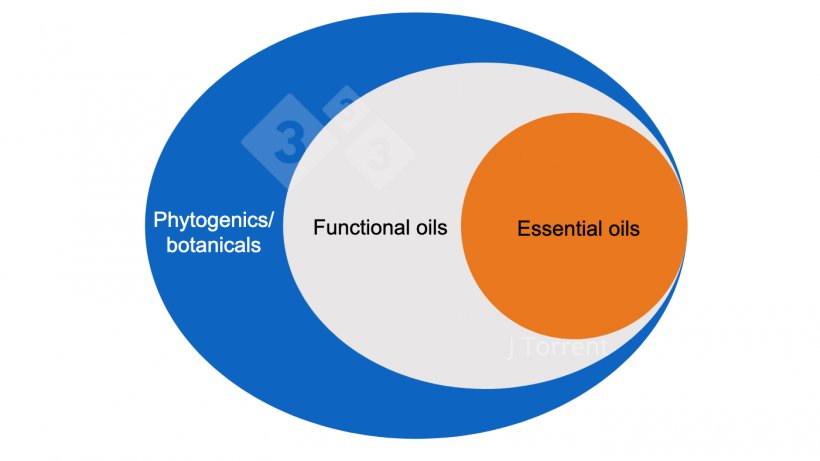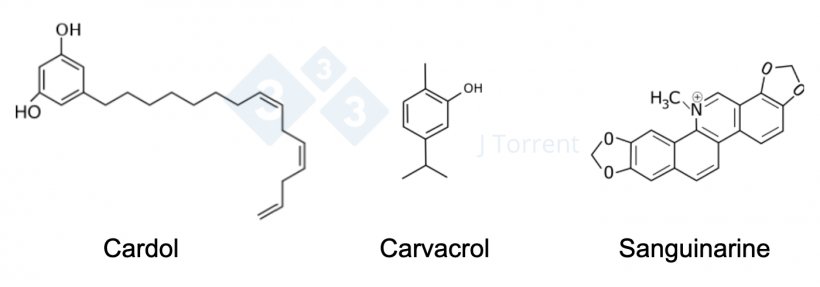Alternative products extracted from plants have appeared in the animal feed additive market due to the governmental regulatory measures that have greatly restricted the use of antibiotics. Unfortunately, different nomenclatures have been used to define them without taking into account that some of these terms are not synonyms and that the wrong use of these terms may lead to a mischaracterization of the product. The feed additive market needs to treat these products as any conventional antibiotic growth promoter, requiring the composition, activity, and quality control of the additive, and the best way to begin to do that is to rightly define each product.
Essential oils

An essential oil is defined by Wikipedia as “a concentrated hydrophobic liquid containing volatile (easily evaporated at normal temperatures) chemical compounds from plants.” Also, these oils are “essential” not in the sense of an essential amino acid or fatty acid (required by the animals), but in the sense that they contain the essence of the plant’s fragrances. Interestingly enough, most of these oils are chemically neither oils nor fatty acids. They are just hydrophobic. Common examples of essential oil products used in animal feeds are orange peel, oregano, thyme, rosemary, or cinnamon oil. Common active compounds found in these oils are thymol, carvacrol, cynnamaldehyde, or limonene. Some commercial products are spiked or formulated with synthetically manufactured (versus naturally extracted) active compounds to assure the quality composition of the products and most are still marketed as essential oils.
Functional oils
Functional oils have been defined as those that have activities beyond their energy value (Bess et a., 2012). These activities vary according to the type of oil, and they include but are not restricted to, antioxidant, antimicrobial, or anti-inflammatory activities. All essential oils are functional oils but not all functional oils are essential oils, as many functional oils are neither volatile nor fragrances. For example, castor oil, cashew nut shell liquid, and medium-chain fatty acids are all hydrophobic compounds but are not volatile, and therefore, are not fragrances. Therefore, they cannot be included in the essential oil classification. Functional oils might or might not be chemically oils. For example, on one hand, castor oil and medium-chain fatty acids are either triglycerides or fatty acids, and on the other hand, cashew nut shell liquid composition is a mix of alkylphenols and their polymers. So, again, we find a great variety of chemical entities.
Botanicals and phytogenic compounds
Botanicals and phytogenic compounds are synonyms and refer to the entire or processed parts of a plant, e.g., roots, leaves, bark (Díaz-Sánchez et al., 2015). So the terms “botanical” or “phytogenic compound” would also include all functional oils and, as explained above, all the essential oils would also be included within the functional oils group.

Botanicals or phytogenics also include non hydrophobic compounds such as fructooligosaccharides (also derived from plants). This example shows how large and how different both from the chemical and from the mode of action the substances in this group can be.
The importance of using the right terminology
Using the right term for the product goes beyond simply using good scientific terminology. It is the first step into making the right decision in regards to which product is the most adequate. Phytogenic compounds are very different and their activities also vary greatly. Nobody would simply use any antibiotic to prevent or treat any disease. Any good professional will look into the type of antibiotic, for example, a beta-lactam, a macrolide, or an ionophore, and decide which one is the most adequate for the pathology that needs to be addressed. The same logic has to be applied to phytogenic compounds. For example, thymol and carvacrol (found in oregano) are different from cardol and cardanol (found in cashew nut shell liquid), and all of these are different from sanguinarine (found in Macleaya cordata).

As potential users of these types of products, we must ask our suppliers for the composition, activity, and quality control as we would for any other “conventional” feed additive. That should be the foundation to an adequate use of these alternatives.



